Why you can trust Tom's Hardware
To read about our monitor tests in-depth, please check out Display Testing Explained: How We Test PC Monitors. Brightness and Contrast testing is covered on page two.
Uncalibrated – Maximum Backlight Level
The PG32UQX is part of an elite category of 4K resolution FALD monitors that can run at 144 Hz. In fact, we found only three others in our database: HP’s Omen X 65 Emerpium, Acer’s Predator X27 and Asus’ ROG Swift PG27UQ. To fill in the extra spaces, we’ve included the Asus ROG Swift PG43UQ and LG’s 27GN950 which are both 4K, 144 Hz screens with edge-array backlights, (a step down from FALD).
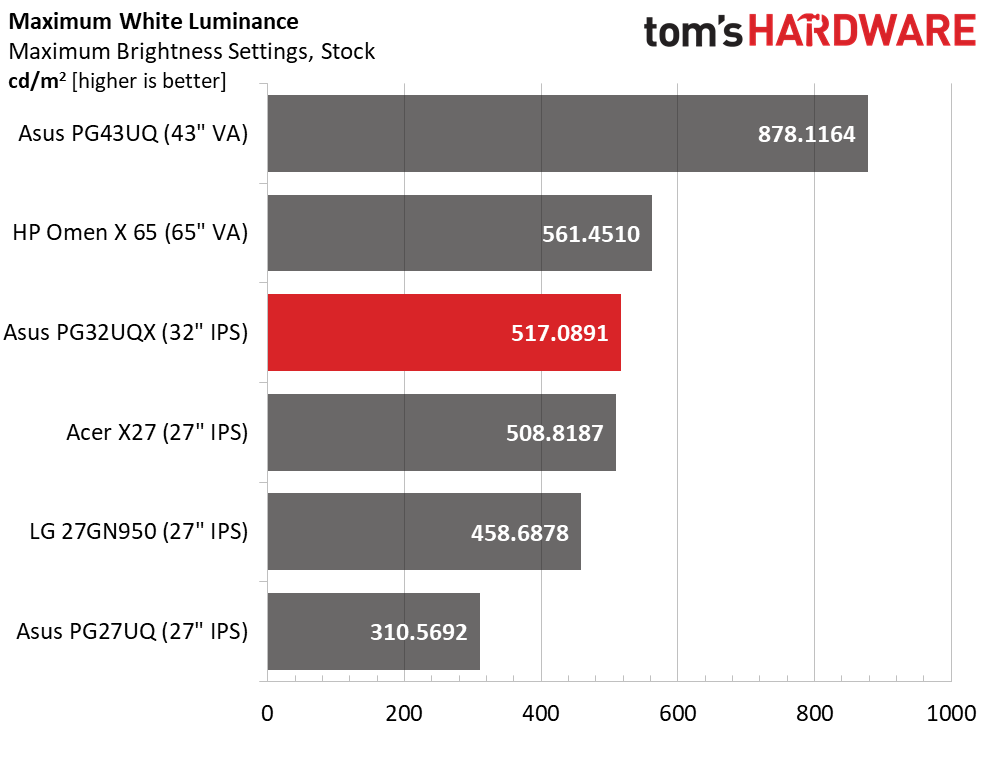
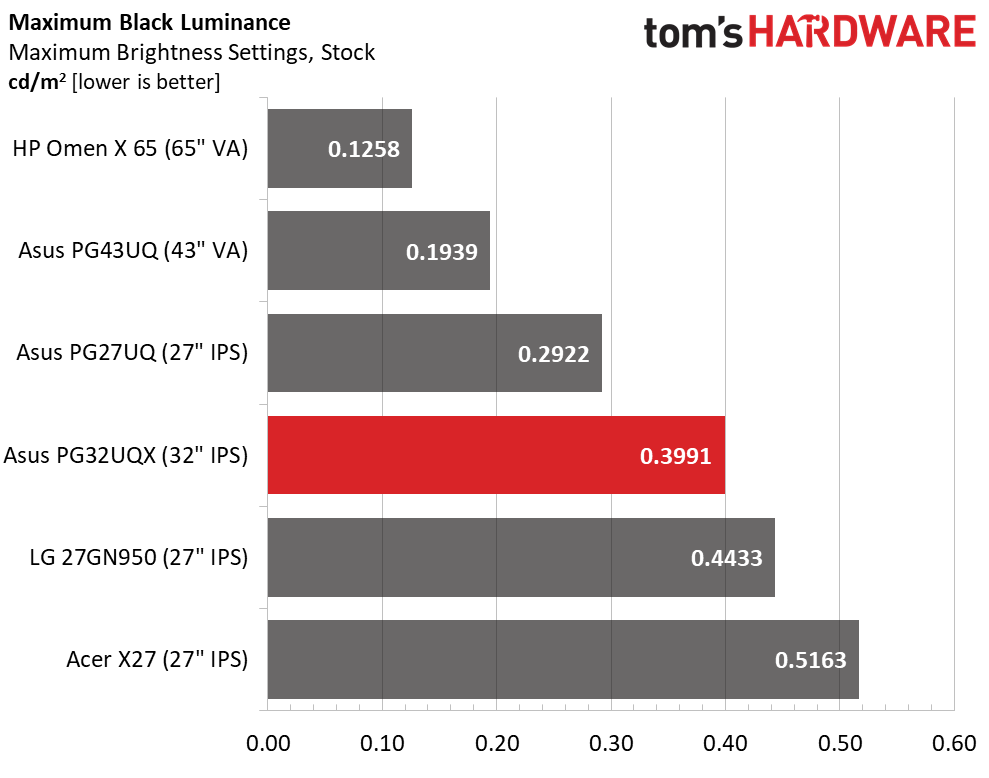
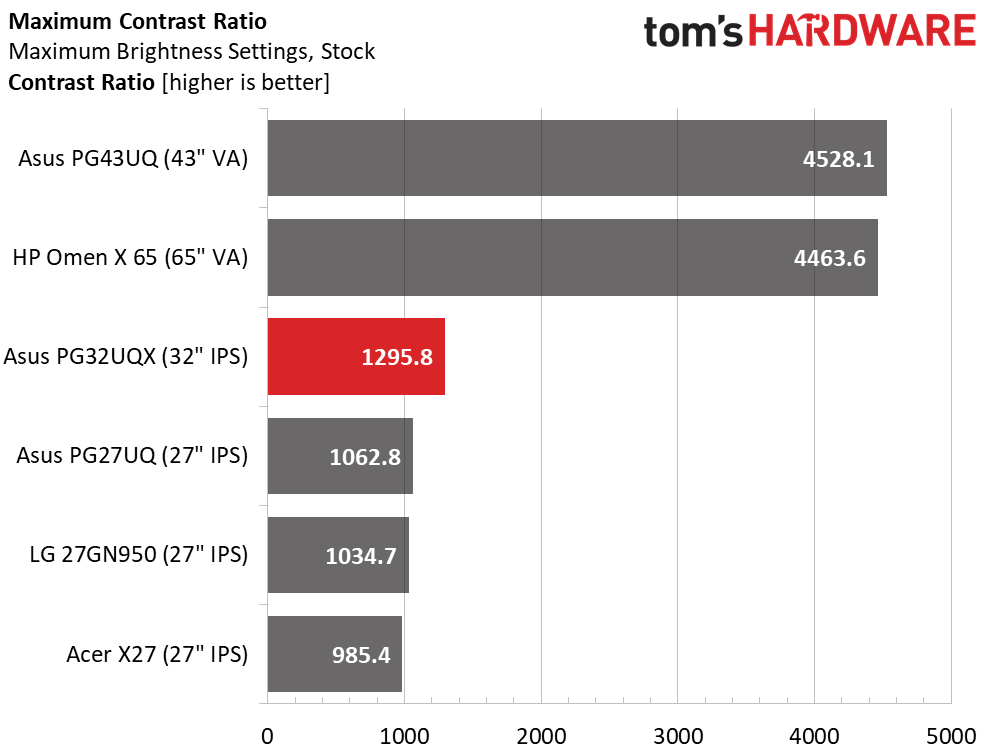
Asus rates the PG32UQX at 500 nits for SDR, and our sample easily exceeded that. For many, anything over 350 nits will be too bright, even in a sunlit room. If you use the variable backlight, you can turn up the brightness favorably because it'll only make highlight areas brighter, while decreasing the black level for greater contrast.
Without its variable backlight, the PG32UQX is a better than average IPS panel with just under 1,300:1 native contrast, an excellent result. We couldn’t calculate contrast with the variable backlight turned on because the black level was too low to measure. In practice though, having the variable backlight on did not clip shadow detail and was useable with all SDR content.
After Calibration to 200 nits
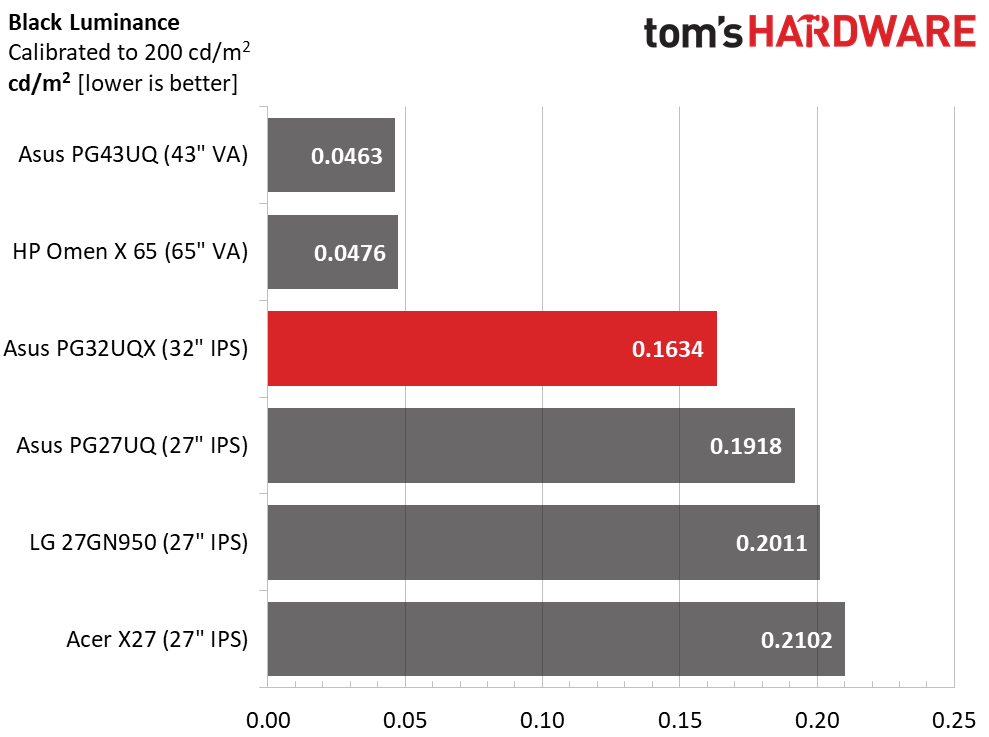
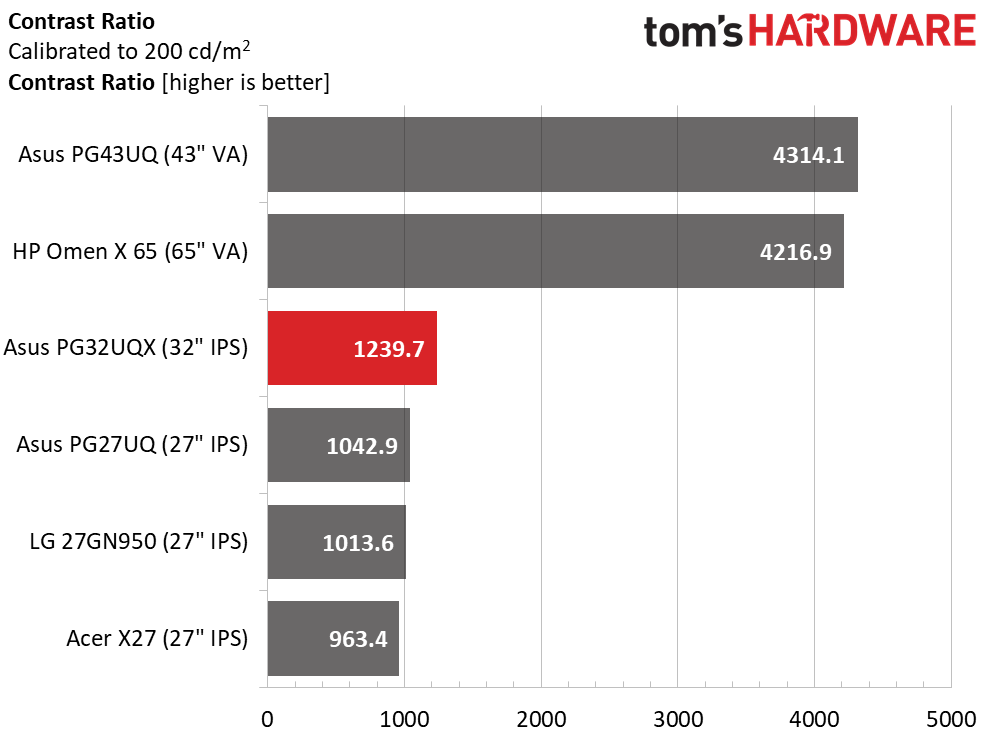
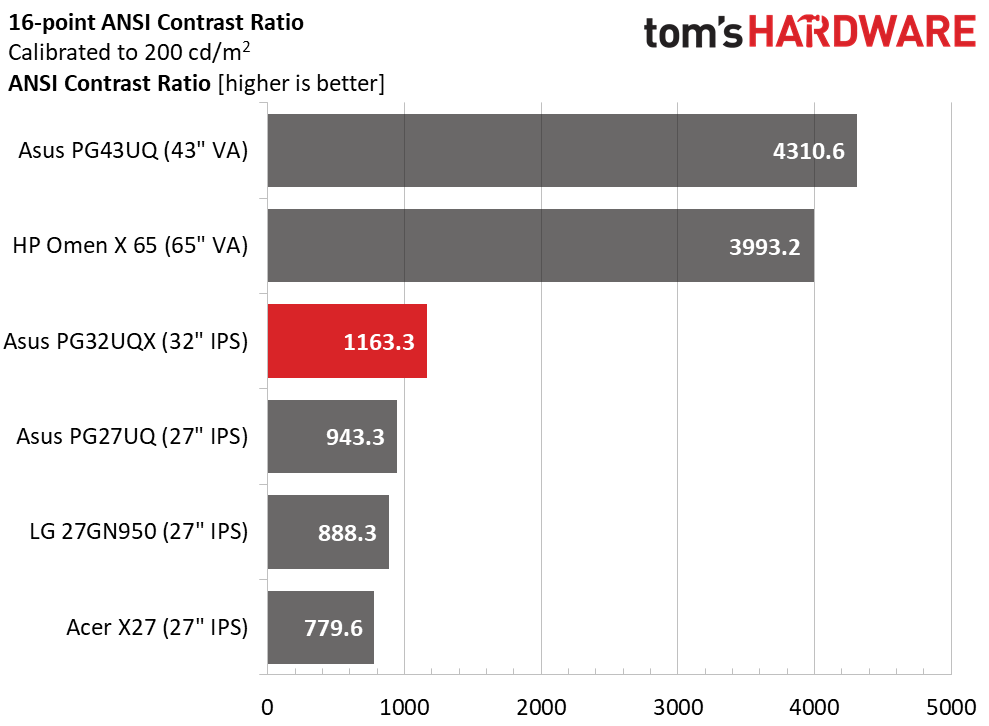
After calibration to 200 nits brightness (see our recommended settings on page 1), the PG32UQX is the best of the IPS panels here with a 0.1634-nit black level and 1,239.7:1 contrast. That’s one of the best results we’ve recorded for any IPS monitor.
ANSI contrast is similarly impressive at 1,163.3:1. Variable backlight doesn’t change the ANSI result but, as we said above, makes static contrast unmeasurable.
Get Tom's Hardware's best news and in-depth reviews, straight to your inbox.
Current page: Brightness and Contrast
Prev Page Features and Specifications Next Page Grayscale, Gamma and Color
Christian Eberle is a Contributing Editor for Tom's Hardware US. He's a veteran reviewer of A/V equipment, specializing in monitors. Christian began his obsession with tech when he built his first PC in 1991, a 286 running DOS 3.0 at a blazing 12MHz. In 2006, he undertook training from the Imaging Science Foundation in video calibration and testing and thus started a passion for precise imaging that persists to this day. He is also a professional musician with a degree from the New England Conservatory as a classical bassoonist which he used to good effect as a performer with the West Point Army Band from 1987 to 2013. He enjoys watching movies and listening to high-end audio in his custom-built home theater and can be seen riding trails near his home on a race-ready ICE VTX recumbent trike. Christian enjoys the endless summer in Florida where he lives with his wife and Chihuahua and plays with orchestras around the state.
-
Vimto94 Hello,Reply
Can you please talk about Blooming? Have you encountered any issue? Difference between this monitor and the PG27UQ on the blooming?
I want to purchase this monitor, but I read reports the haloing/blooming is bad -
truerock Reply
I think NOT having speakers inside my monitor is an extremely positive thing.Admin said:The Asus ROG Swift PG32UQX is a Mini LED gaming monitor with a tremendous feature list. It may just be the ultimate computer monitor – if you can afford it.
Asus ROG Swift PG32UQX Mini LED Gaming Monitor Review: The Ultimate Computer Monitor? : Read more
This article suggests that it is desirable to have speakers inside your monitor. I strongly disagree.
My preference is to have nothing built into my monitor except the display panel and a USB-C port. -
Makaveli Replytruerock said:I think NOT having speakers inside my monitor is an extremely positive thing.
This article suggests that it is desirable to have speakers inside your monitor. I strongly disagree.
My preference is to have nothing built into my monitor except the display panel and a USB-C port.
Ditto don't need speakers on a monitor for me personally. -
spongiemaster Reply
Agree completely. If you can afford $3000 for a monitor you can absolutely afford some decent headphones or speakers to pair with it. Leave the $2 garbage speakers out of the monitor.truerock said:I think NOT having speakers inside my monitor is an extremely positive thing.
This article suggests that it is desirable to have speakers inside your monitor. I strongly disagree.
My preference is to have nothing built into my monitor except the display panel and a USB-C port. -
ssj3rd 3.000$ and no Dolby Vision Support?Reply
I don’t get it…
Halo infinite will have Dolby Vision, for example.
I’m waiting eagerly for the Test for the PG32UQ, with a price tag 999€ it’s way more realistic and affordable. -
jakjawagon Is it common for monitors to not accept a 24hz signal? Or to display content from a blu-ray player or streaming box at the wrong framerate?Reply
I know a lot of TVs come with 'motion smoothing' on by default, but I didn't think PC monitors did.
I am not a monitor expert, but 'accepting film cadences' doesn't sound like a notable feature. -
hotaru.hino Reply
It's not common because monitors aren't expected to be used like TVs.jakjawagon said:Is it common for monitors to not accept a 24hz signal? Or to display content from a blu-ray player or streaming box at the wrong framerate?
I know a lot of TVs come with 'motion smoothing' on by default, but I didn't think PC monitors did.
I am not a monitor expert, but 'accepting film cadences' doesn't sound like a notable feature. -
Gigahertz20 Uhhhh $3k for this or just pay $1300 or so for the LG CX 4k 48" OLED...hmmm OLED please.Reply -
HyperMatrix This is a garbage monitor made using 3 year old tech. It’s the exact same as the PG27UQ with the exception of the “mini led” backlight system which isn’t that impressive either. Each zone is half the size of those on the PG27UQ. So the bloom zones will be slightly smaller, but still hugely problematic. Secondly...the price is ridiculous. $3000 for garbage. There is nothing new or cutting edge in this monitor. It doesn’t even support HDMI 2.1.Reply -
helper800 Reply
Exactly what I did except I got the 55 inch CX. At 3000 dollars I would rather have the LG G1 because its the latest and greatest OLED with as many lighting zones as there are pixels.Gigahertz20 said:Uhhhh $3k for this or just pay $1300 or so for the LG CX 4k 48" OLED...hmmm OLED please.